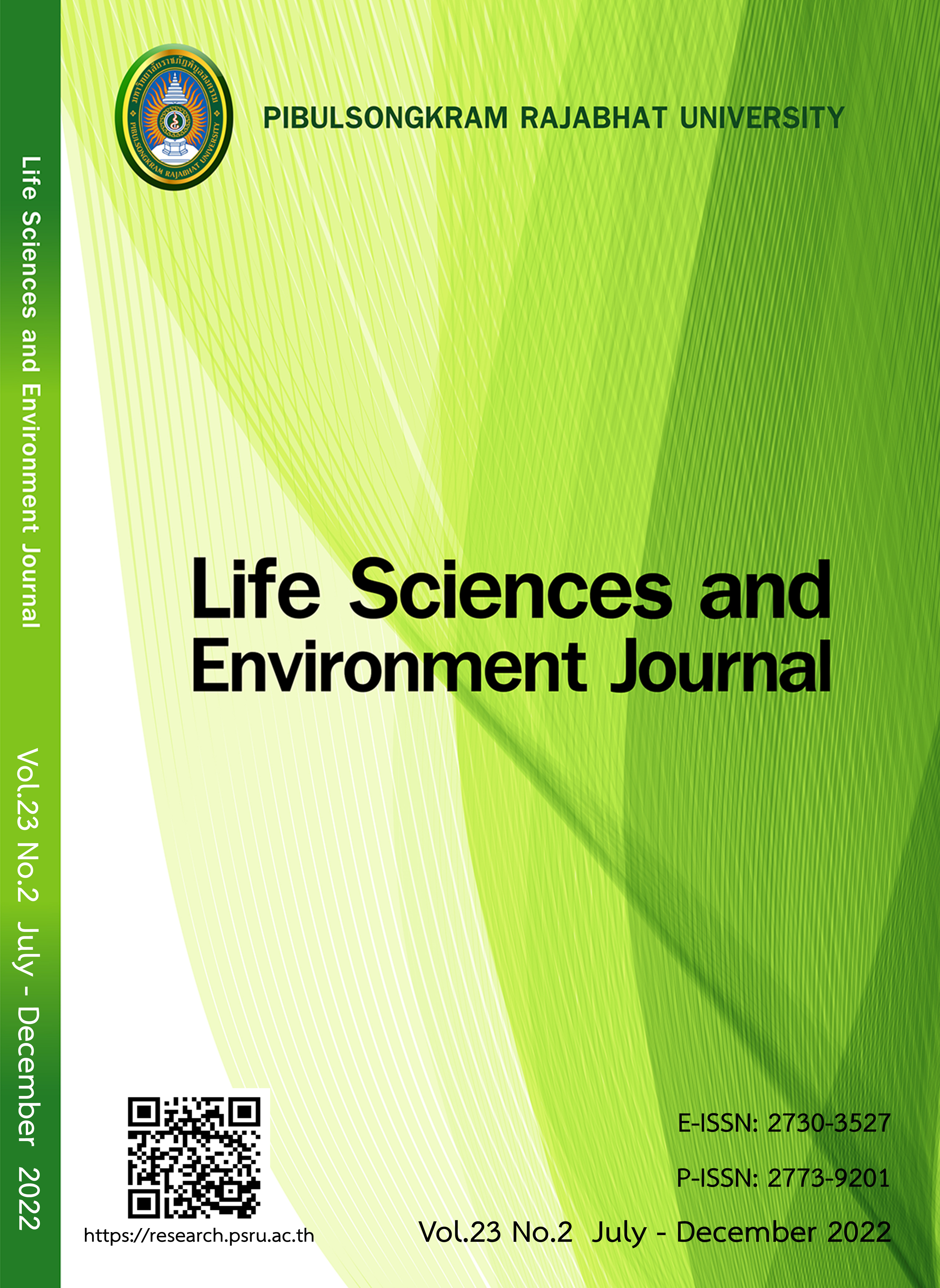RELATIONSHIP OF AQUATIC ENVIRONMENTAL PARAMETERS AND PHYTOPLANKTON DENSITY IN PARKMENG ESTUARY, SIKAO DISTRICT, TRANG PROVINCE
DOI:
https://doi.org/10.14456/lsej.2022.21Keywords:
Phytoplankton, Aquatic parameter, Relationship , Estuary, Andaman SeaAbstract
Parkmeng Estuary is located in Siako District area, Trang Province, the estuary is an important nursery area for marine life; however, port construction and tourist activities affect the estuarine environmental quality. It is necessary to study effect of those activities on the environment and biological qualities in this area. The relationships between aquatic environment parameters (AEP) and phytoplankton density in this estuary were investigated using the canonical correspondence analysis (CCA) method. The AEP was classified for two main seasons, monsoon (July-October) and summer seasons (November-April) by the unweighted pair group method with arithmetic mean analysis with similarity scores of 98.79% and 98.18%. The inter-change period was May classified by CCA score at 99.54%. Two divisions, 11 families, 14 genera, and 17 species of phytoplankton were recorded in this study. The division Chromophyta showed the highest density (74.96%) followed by Cyanophyta (26.04%). Similar to AEP analysis, phytoplankton was classified as monsoon or summer species with CCA similarity scores of 74.28% and 55.00%, respectively. Phosphate, conductivity, silicates, pH, and temperature showed correlations to phytoplankton density with CCA variable scores of 0.84, 0.75, 0.74, 0.72, and 0.71, respectively. This study reveals that the density of Triceratium sp., Rhizosolenia sp., Odontella sp., and Cyclotella stylorum diatoms might be used as bio-indicators for the fluctuations of salinity and pH in this estuary.
References
Barinova S, Krupa E. Bioindication of ecological state and water quality by phytoplankton in the Shardara Reservoir. Kazakhstan. Environment and Ecology Research 2017;5:73-92.
Chatterjee A, Shankar D, McCreary JP, Vinayachandran PN, Mukherjee A. Dynamics of andaman sea circulation and its role in connecting the equatorial Indian Ocean to the Bay of Bengal. Journal of Geophysical Research Oceans 2017;22(4):3200-3218.
Devaraj K, Steffes PG. Duong D. The centimeter-wavelength opacity of ammonia under deep jovian conditions. Icarus 2014;241:165-179.
Li M, Shi X, Guo C, Lin S. Phosphorus deficiency inhibits cell division but not growth in the dinoflagellate Amphidinium carterae. Frontiers in Microbiology 2016;7:826.
Li X, Yu H, Wang H, Ma C. Phytoplankton community structure in relation to environmental factors and ecological assessment of water quality in the upper reaches of the Gene River in the Greater Hinggan Mountains. Environmental Science and Pollution Research 2019; 26(17):17512-17519.
Kraberg A, Baumann M, Durselen CD. Coastal Phytoplankton: photo guide for Northern European Seas. 2010; Munich: Verlag Dr. Friedrich Pfeil.
Llebot C, Spitz YH, Sole J, Estrada M. The role of inorganic nutrients and dissolved organic phosphorus in the phytoplankton dynamics of a Mediterranean bay: a modeling study. Journal of Marine Systems 2010;83(3-4):192-209.
Medupin C. Phytoplankton community and their impact on water quality: an analysis of Hollingsworth Lake UK. Journal of Applied Sciences and Environmental Management 2011;15(2):347-350.
Mishra P, Garg V, Dutt K. Seasonal dynamics of phytoplankton population and water quality in Bidoli reservoir. Environmental Monitoring and Assessment 2019;191:130.
Mohanty AK, Satpathy KK, Sahu G, Hussain KJ, Prasad MVR, Sarkar SK. Bloom of Trichodesmium erythraeum (Ehr.) and its impact on water quality and plankton community structure in the coastal waters of southeast coast of India. Indian Journal of Marine Science 2010;39(3):323-333.
Snoeijs P, Weckstrom K. Diatoms and environmental change in large brackish-water ecosystems”, in The diatoms: applications for the Environmental and earth sciences. (Ed. J. P. Smol, and E. F. Stoermer), Cambridge, U.K., Cambridge University Press; 2010.
Strickland JDH, Parson TR. A practical handbook of sea water analysis. Fisheries research board of canada, Ottawa, 1972.
Thawonsode N, Meksumpun S, Kasamesiri P. Relationship between environmental conditions and recovery of the coral reefs in the Andaman coast of Thailand. ScienceAsia 2015;41:217-228.
Trombetta T, Vidussi F, Mas S, Parin D, Simier M, Mostajir B. Water temperature drives phytoplankton blooms in coastal waters. Plos One 2019;14:1-28.
Velsamy G, Manoharan N. Ganesan S. Analysis of physico-chemical variations in sea water samples Uppanar Estuary, Cuddalore, Tamilnadu, India. International Journal of Biological Sciences 2013;3:80-83.
Wafa MFN, Hasan Z, Gumilar I, Sahidin A. Plankton community structure and its relationship with minerals profiles in minapadi area, Talagasari village, kadungora garut regency. Asian Journal of Fisheries and Aquatic Research 2019;4(2):1-13.
Xiao T, Zhong W, Xu L, Sun XQ, Hu XY, Wang L. Supramolecular vesicles based on pillar[n] arenes:
design, construction, and applications. Organic and Biomolecular Chemistry 2019;17(6):1336-1350.
Downloads
Published
How to Cite
Issue
Section
License
Copyright (c) 2022 Life Sciences and Environment Journal

This work is licensed under a Creative Commons Attribution-NonCommercial-NoDerivatives 4.0 International License.
Each article is copyrighted © by its author(s) and is published under license from the author(s).










